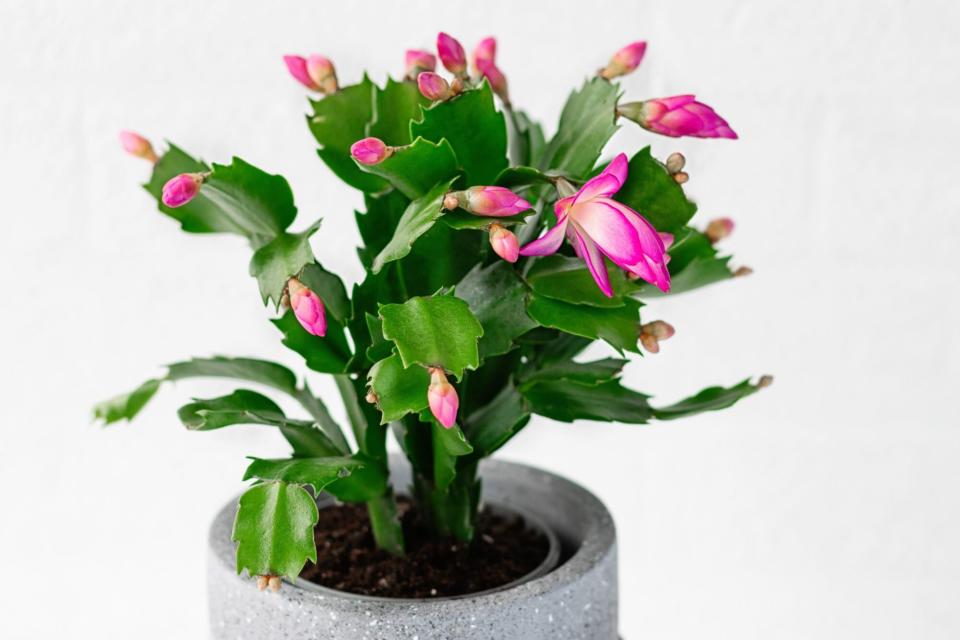How to Care for a Thanksgiving Cactus, a Houseplant That Blooms in Tandem With the Holiday
TABLE OF CONTENTS
On This Page
Holiday Cactus Varieties
Care Requirements
How to Force Blooming
Thanksgiving cactus falls within the genus Schlumbergera, along with other holiday-themed plants like Christmas and Easter iterations. These low-maintenance plants are known for their flat, segmented deep-green foliage and beautifully layered flowers that seem to appear right as the celebrations they are named for arrive.
As you'd expect, the Thanksgiving cactus blooms right around Turkey Day—which makes it a wonderful centerpiece or hostess present. Ahead, how to care for yours, whether you decide to gift or ultimately receive one.
Related: How to Care for Your Christmas Cactus

Elena Grishina / Getty Images
Thanksgiving Cactus vs. Other Holiday Varieties
Also known as Schlumbergera truncata, the Thanksgiving cactus is a fall-blooming variety of the Schlumbergera genius. It is one of three popular holiday cacti, and though they're all quite similar, each has its own defining characteristics.
Christmas Cactus
Thanksgiving cacti are classified as epiphytes, which means they commonly grow on other flowers and greens, like orchids, moss, and fern. While Christmas cactus (Schlumbergera bridgesti) is also a type of epiphyte, there is one key difference between the two. "Thanksgiving cactus differs from Christmas cactus in that it forms small teeth along the leaf margins, along with the formation of yellow anthers," says Corwin Graves, the vice president of growing for Green Circle Growers.
Easter Cactus
Another variety of holiday cactus is the Easter cactus, or Schlumbergera gaertnerrii. Different from the other two cacti, this iteration has rounder edges. The care across the three plants remains mostly the same.
Thanksgiving Cactus Care Requirements
Thanksgiving cacti are semi-tropical, so they're best grown as houseplants or outdoors in USDA zones 10 through 12. When growing inside, be sure to keep your thermostat at an ideal temperature for the plant—about 58 and 72 degrees.
Light
Your Thanksgiving cactus requires different types of light depending on the season. According to Graves, the plant should be exposed to bright light during winter and filtered light in the summer.
Water
Unlike true cacti, which can survive weeks without water, a Thanksgiving cactus needs to be on a routine watering schedule. Be sure to keep the top few inches of soil moist to the touch—not dry or waterlogged.
Soil
Thanksgiving cactus must be planted in well-drained soil that has good aeration, as epiphytic cacti aren't able to thrive in potting mixes that are wet. Additionally, soil for this plant variety should be pH balanced.
Fertilizer
Despite the fact that these houseplants produce a gorgeous show of blooms during their growing season—sometimes for two to four months at a time—they require very little in the way of soil amendments. This is why Graves says any commonly available water-soluble fertilizer should be sufficient when applied at the low recommended rate.
How to Encourage a Thanksgiving Cactus to Bloom
The Thanksgiving cactus begins its floral show when the cooler temperatures and shorter days of fall approach—so you can encourage yours to flower by replicating these conditions in your home. According to Graves, flowering is triggered by either cool temperatures (50 through 58 degrees) or day length (shorter days), though day length is the most common flowering trigger inside the home.
"Plants will initiate flowers when days are 12-and-a-half hours or shorter, and they will remain vegetative at 14 hours and above," she says. The delicate, multilayer flowers appear in various shades of white, yellow, red, and, pink.

